Settling Velocity of Microplastics Exposed to Wave Action
Abstract
1. Introduction
2. Materials and Methods
2.1. Experimental Setup
2.2. Particles
2.3. Test Cases
2.4. Settling Trajectory Measurements
3. Results and Discussion
3.1. Measured Particle Trajectories
3.2. the Role of the Inertial Stokes Drift on the Net Settling Velocity
3.3. A New Formulation of the Settling Velocity
3.4. Scaling Argument and Applicability of the Results
4. Conclusions
Author Contributions
Funding
Institutional Review Board Statement
Informed Consent Statement
Data Availability Statement
Acknowledgments
Conflicts of Interest
References
- Villarrubia-Gómez, P.; Cornell, S.E.; Fabres, J. Marine plastic pollution as a planetary boundary threat–The drifting piece in the sustainability puzzle. Mar. Policy 2018, 96, 213–220. [Google Scholar] [CrossRef]
- PlasticsEurope. Annual Report 2018 “Plastics—the Facts 2018. An Analysis of European Latest Plastics Production, Demand and Waste Data”; Technical Report; PlasticsEurope: Brussels, Belgium, 2018. [Google Scholar]
- Hidalgo-Ruz, V.; Gutow, L.; Thompson, R.C.; Thiel, M. Microplastics in the marine environment: A review of the methods used for identification and quantification. Environ. Sci. Technol. 2012, 46, 3060–3075. [Google Scholar] [CrossRef] [PubMed]
- Hartmann, N.B.; Huffer, T.; Thompson, R.C.; Hassellov, M.; Verschoor, A.; Daugaard, A.E.; Rist, S.; Karlsson, T.; Brennholt, N.; Cole, M. Are we speaking the same language? Recommendations for a definition and categorization framework for plastic debris. Environ. Sci. Technol. 2019, 53, 1039–1047. [Google Scholar] [CrossRef] [PubMed]
- Cutroneo, L.; Reboa, A.; Besio, G.; Borgogno, F.; Canesi, L.; Canuto, S.; Dara, M.; Enrile, F.; Forioso, I.; Greco, G.; et al. Microplastics in seawater: Sampling strategies, laboratory methodologies, and identification techniques applied to port environment. Environ. Sci. Pollut. Res. 2020, 27, 8938–8952. [Google Scholar] [CrossRef] [PubMed]
- Kooi, M.; Koelmans, A.A. Simplifying microplastic via continuous probability distributions for size, shape, and density. Environ. Sci. Technol. Lett. 2019, 6, 551–557. [Google Scholar] [CrossRef]
- Kaiser, D.; Kowalski, N.; Waniek, J.J. Effects of biofouling on the sinking behavior of microplastics. Environ. Res. Lett. 2017, 12, 124003. [Google Scholar] [CrossRef]
- Kooi, M.; Nes, E.H.v.; Scheffer, M.; Koelmans, A.A. Ups and downs in the ocean: Effects of biofouling on vertical transport of microplastics. Environ. Sci. Technol. 2017, 51, 7963–7971. [Google Scholar] [CrossRef]
- Porter, A.; Lyons, B.P.; Galloway, T.S.; Lewis, C. Role of marine snows in microplastic fate and bioavailability. Environ. Sci. Technol. 2018, 52, 7111–7119. [Google Scholar] [CrossRef]
- Chubarenko, I.; Bagaev, A.; Zobkov, M.; Esiukova, E. On some physical and dynamical properties of microplastic particles in marine environment. Mar. Pollut. Bull. 2016, 108, 105–112. [Google Scholar] [CrossRef]
- Khatmullina, L.; Isachenko, I. Settling velocity of microplastic particles of regular shapes. Mar. Pollut. Bull. 2017, 114, 871–880. [Google Scholar] [CrossRef]
- Waldschlager, K.; Schuttrumpf, H. Effects of particle properties on the settling and rise velocities of microplastics in freshwater under laboratory conditions. Environ. Sci. Technol. 2019, 53, 1958–1966. [Google Scholar] [CrossRef] [PubMed]
- Law, K.L. Plastics in the marine environment. Annu. Rev. Mar. Sci. 2017, 9, 205–229. [Google Scholar] [CrossRef] [PubMed]
- Rezania, S.; Park, J.; Din, M.F.M.; Taib, S.M.; Talaiekhozani, A.; Yadav, K.K.; Kamyab, H. Microplastics pollution in different aquatic environments and biota: A review of recent studies. Mar. Pollut. Bull. 2018, 133, 191–208. [Google Scholar] [CrossRef]
- Bergmann, M.; Wirzberger, V.; Krumpen, T.; Lorenz, C.; Primpke, S.; Tekman, M.B.; Gerdts, G. High quantities of microplastic in Arctic deep-sea sediments from the HAUSGARTEN observatory. Environ. Sci. Technol. 2017, 51, 11000–11010. [Google Scholar] [CrossRef] [PubMed]
- Suaria, G.; Perold, V.; Lee, J.R.; Lebouard, F.; Aliani, S.; Ryan, P.G. Floating macro-and microplastics around the Southern Ocean: Results from the Antarctic Circumnavigation Expedition. Environ. Int. 2020, 136, 105494. [Google Scholar] [CrossRef] [PubMed]
- Maximenko, N.; Hafner, J.; Niiler, P. Pathways of marine debris derived from trajectories of Lagrangian drifters. Mar. Pollut. Bull. 2012, 65, 51–62. [Google Scholar] [CrossRef]
- Ballent, A.; Pando, S.; Purser, A.; Juliano, M.; Thomsen, L. Modelled transport of benthic marine microplastic pollution in the Nazaré Canyon. Biogeosciences 2013, 10, 7957. [Google Scholar] [CrossRef]
- Zambianchi, E.; Trani, M.; Falco, P. Lagrangian transport of marine litter in the Mediterranean Sea. Front. Environ. Sci. 2017, 5, 5. [Google Scholar] [CrossRef]
- Kukulka, T.; Proskurowski, G.; Morét-Ferguson, S.; Meyer, D.; Law, K. The effect of wind mixing on the vertical distribution of buoyant plastic debris. Geophys. Res. Lett. 2012, 39. [Google Scholar] [CrossRef]
- Isobe, A.; Kubo, K.; Tamura, Y.; Nakashima, E.; Fujii, N. Selective transport of microplastics and mesoplastics by drifting in coastal waters. Mar. Pollut. Bull. 2014, 89, 324–330. [Google Scholar] [CrossRef]
- Kukulka, T.; Brunner, K. Passive buoyant tracers in the ocean surface boundary layer: 1. Influence of equilibrium wind-waves on vertical distributions. J. Geophys. Res. Ocean. 2015, 120, 3837–3858. [Google Scholar] [CrossRef]
- Brunner, K.; Kukulka, T.; Proskurowski, G.; Law, K. Passive buoyant tracers in the ocean surface boundary layer: 2. Observations and simulations of microplastic marine debris. J. Geophys. Res. Ocean. 2015, 120, 7559–7573. [Google Scholar] [CrossRef]
- Zhang, H. Transport of microplastics in coastal seas. Estuar. Coast. Shelf Sci. 2017, 199, 74–86. [Google Scholar] [CrossRef]
- Liubartseva, S.; Coppini, G.; Lecci, R.; Creti, S. Regional approach to modeling the transport of floating plastic debris in the Adriatic Sea. Mar. Pollut. Bull. 2016, 103, 115–127. [Google Scholar] [CrossRef] [PubMed]
- Liubartseva, S.; Coppini, G.; Lecci, R.; Clementi, E. Tracking plastics in the Mediterranean: 2D Lagrangian model. Mar. Pollut. Bull. 2018, 129, 151–162. [Google Scholar] [CrossRef]
- Maxey, M.; Riley, J. Equation of motion for a small rigid sphere in a nonuniform flow. Phys. Fluids 1983, 26, 883–889. [Google Scholar] [CrossRef]
- Santamaria, F.; Boffetta, G.; Afonso, M.M.; Mazzino, A.; Onorato, M.; Pugliese, D. Stokes drift for inertial particles transported by water waves. EPL (Europhys. Lett.) 2013, 102, 14003. [Google Scholar] [CrossRef]
- Stocchino, A.; De Leo, F.; Besio, G. Sea Waves Transport of Inertial Micro-Plastics: Mathematical Model and Applications. J. Mar. Sci. Eng. 2019, 7, 467. [Google Scholar] [CrossRef]
- DiBenedetto, M.H.; Ouellette, N.T.; Koseff, J.R. Transport of anisotropic particles under waves. J. Fluid Mech. 2018, 837, 320–340. [Google Scholar] [CrossRef]
- Forsberg, P.L.; Sous, D.; Stocchino, A.; Chemin, R. Behaviour of plastic litter in nearshore waters: First insights from wind and wave laboratory experiments. Mar. Pollut. Bull. 2020, 153, 111023. [Google Scholar] [CrossRef]
- Drevard, D.; Rey, V.; Fraunié, P. Partially standing wave measurement in the presence of steady current by use of coincident velocity and/or pressure data. Coast. Eng. 2009, 56, 992–1001. [Google Scholar] [CrossRef]
- Rey, V.; Capobianco, R.; Dulou, C. Wave scattering by a submerged plate in presence of a steady uniform current. Coast. Eng. 2002, 47, 27–34. [Google Scholar] [CrossRef]
- LeMéhauté, B. An introduction to Hydrodynamics and Water Waves; Environmental Science Servies Administration: Berlin, Germany, 1969; Volume 52. [Google Scholar]
- Stokes, G.G. On the Effect of the Internal Friction of Fluids on the Motion of Pendulums; Pitt Press Cambridge: Cambridge, UK, 1851; Volume 9. [Google Scholar]
- Kumar, N.; Cahl, D.L.; Crosby, S.C.; Voulgaris, G. Bulk versus spectral wave parameters: Implications on stokes drift estimates, regional wave modeling, and HF radars applications. J. Phys. Oceanogr. 2017, 47, 1413–1431. [Google Scholar] [CrossRef]
- Jalón-Rojas, I.; Xiao-Hua, W.; Fredj, E. On the importance of a three-dimensional approach for modelling the transport of neustic microplastics. Ocean. Sci. 2019, 15, 717–724. [Google Scholar] [CrossRef]
- Beron-Vera, F.J.; Olascoaga, M.J.; Miron, P. Building a Maxey–Riley framework for surface ocean inertial particle dynamics. Phys. Fluids 2019, 31, 096602. [Google Scholar] [CrossRef]
- Dietrich, W.E. Settling velocity of natural particles. Water Resour. Res. 1982, 18, 1615–1626. [Google Scholar] [CrossRef]
- Zhiyao, S.; Tingting, W.; Fumin, X.; Ruijie, L. A simple formula for predicting settling velocity of sediment particles. Water Sci. Eng. 2008, 1, 37–43. [Google Scholar] [CrossRef]
- Clift, R.; Grace, J.; Weber, M. Nonspherical rigid particles at higher Reynolds numbers. In Bubbles, Drops, and Particles; Academic Press: New York, NY, USA, 1978; pp. 142–168. [Google Scholar]
- Moré, J.J.; Sorensen, D.C. Computing a trust region step. SIAM J. Sci. Stat. Comput. 1983, 4, 553–572. [Google Scholar] [CrossRef]
- Steihaug, T. The conjugate gradient method and trust regions in large scale optimization. SIAM J. Numer. Anal. 1983, 20, 626–637. [Google Scholar] [CrossRef]
- Coleman, T.F.; Li, Y. An interior trust region approach for nonlinear minimization subject to bounds. SIAM J. Optim. 1996, 6, 418–445. [Google Scholar] [CrossRef]
- McDermid, K.J.; McMullen, T.L. Quantitative analysis of small-plastic debris on beaches in the Hawaiian archipelago. Mar. Pollut. Bull. 2004, 48, 790–794. [Google Scholar] [CrossRef] [PubMed]
- Morét-Ferguson, S.; Law, K.L.; Proskurowski, G.; Murphy, E.K.; Peacock, E.E.; Reddy, C.M. The size, mass, and composition of plastic debris in the western North Atlantic Ocean. Mar. Pollut. Bull. 2010, 60, 1873–1878. [Google Scholar] [CrossRef] [PubMed]
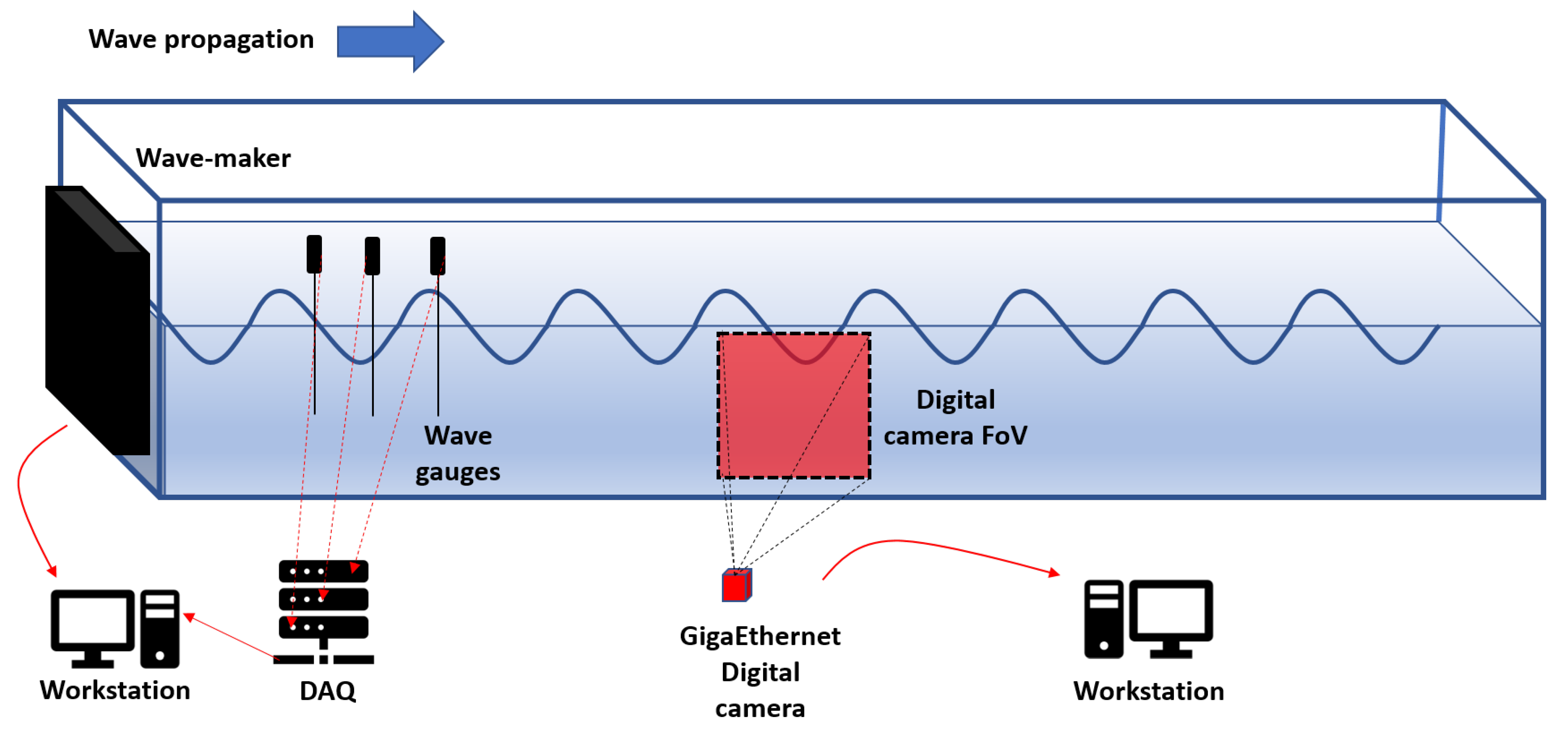
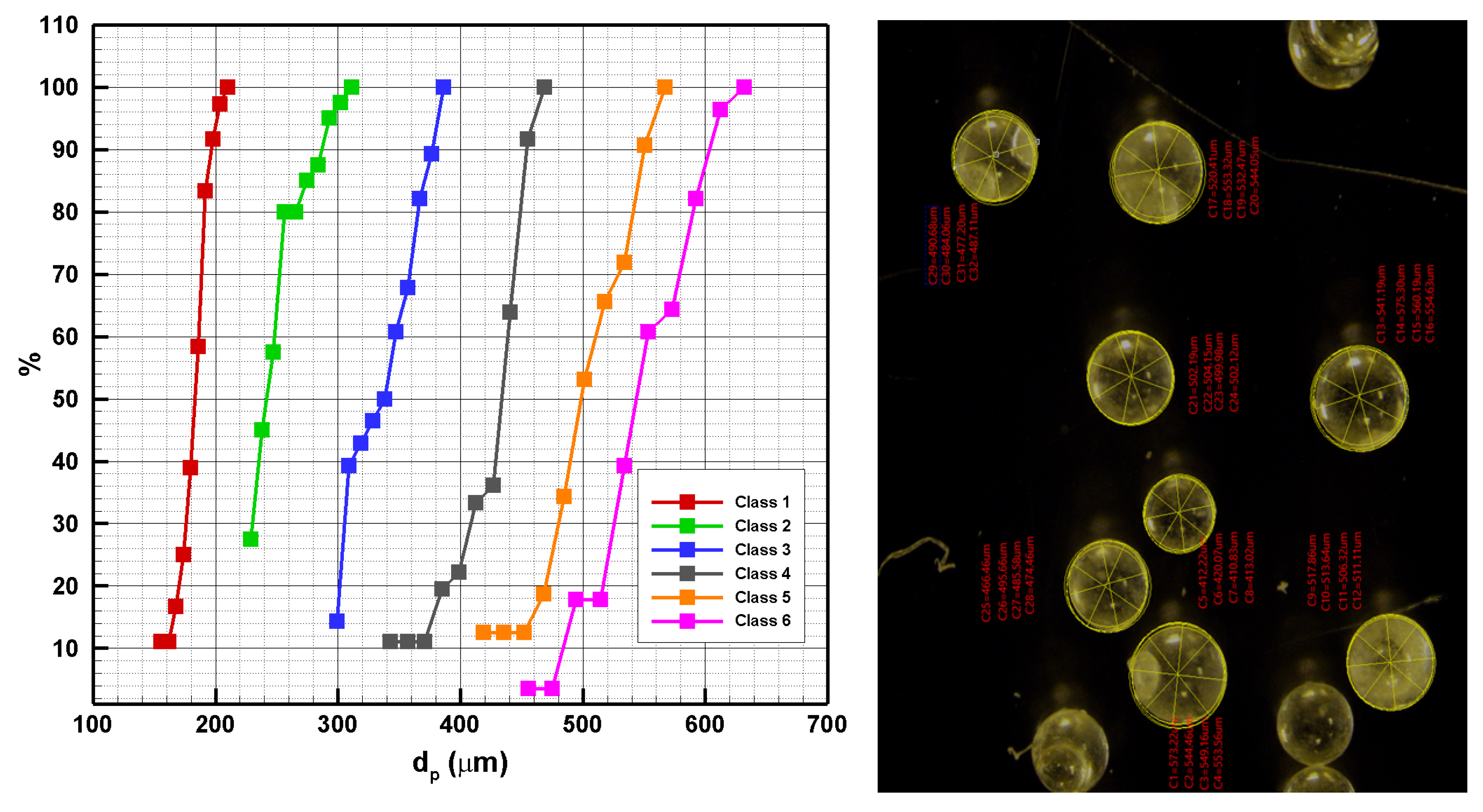
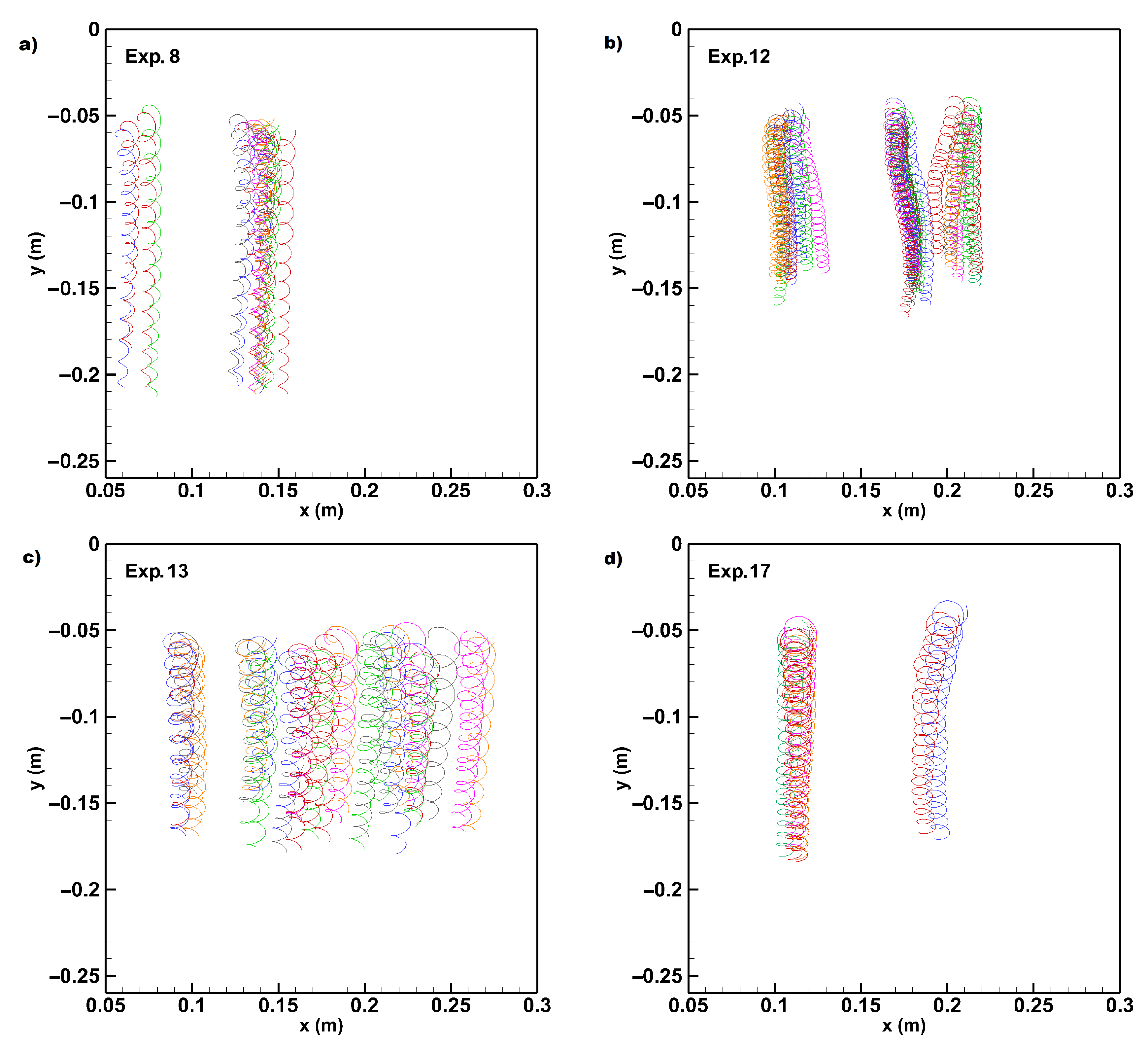
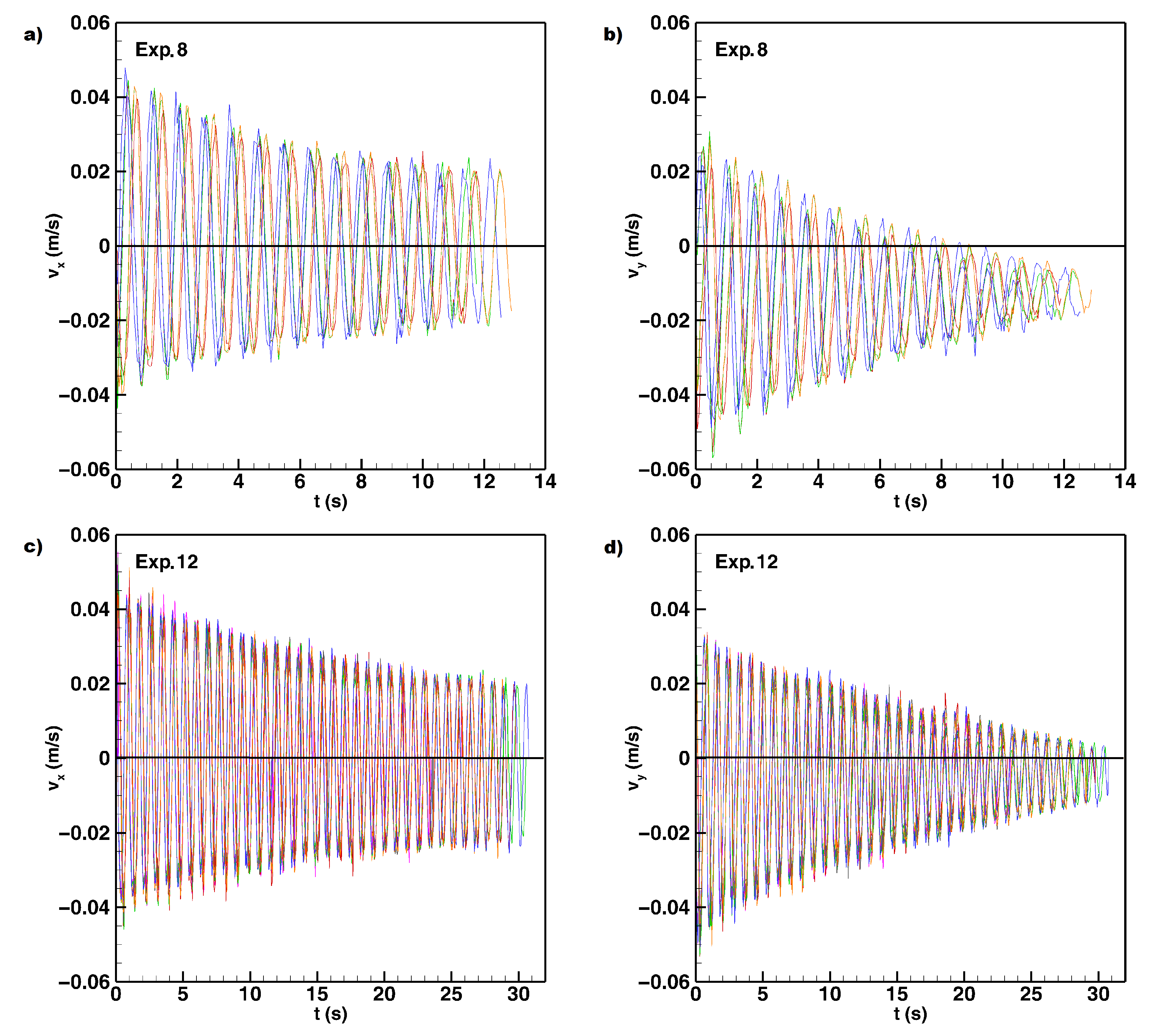

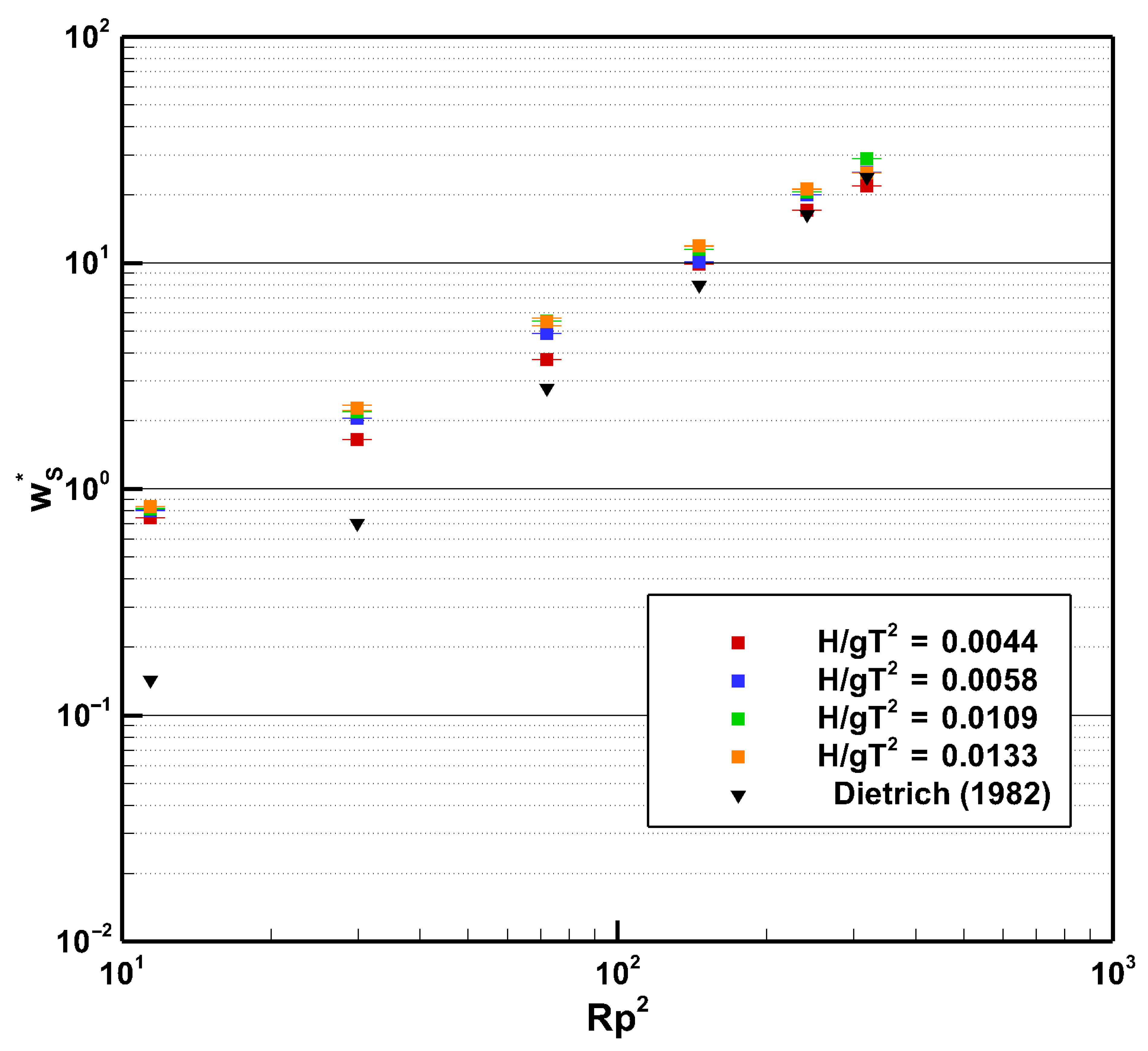
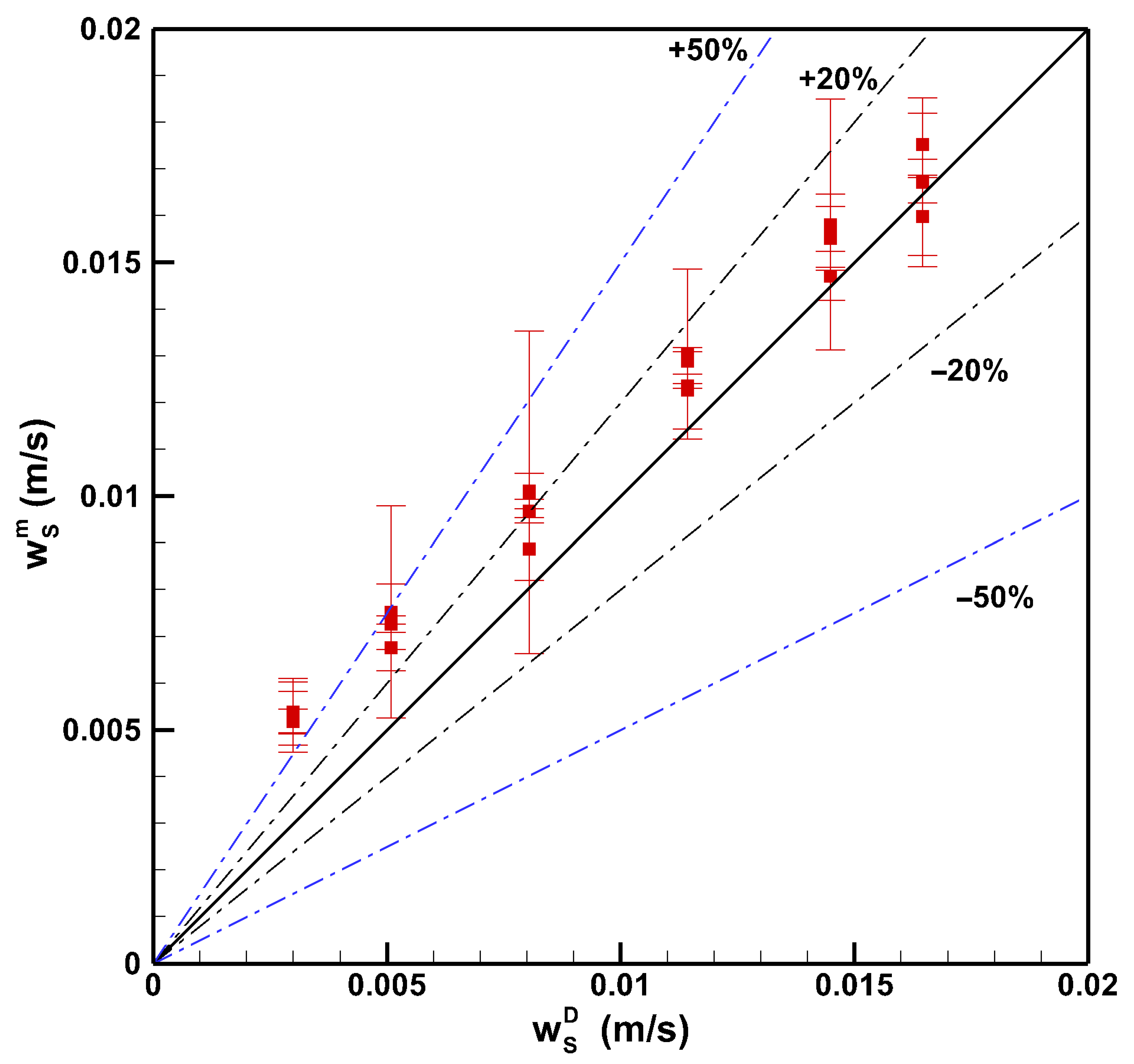
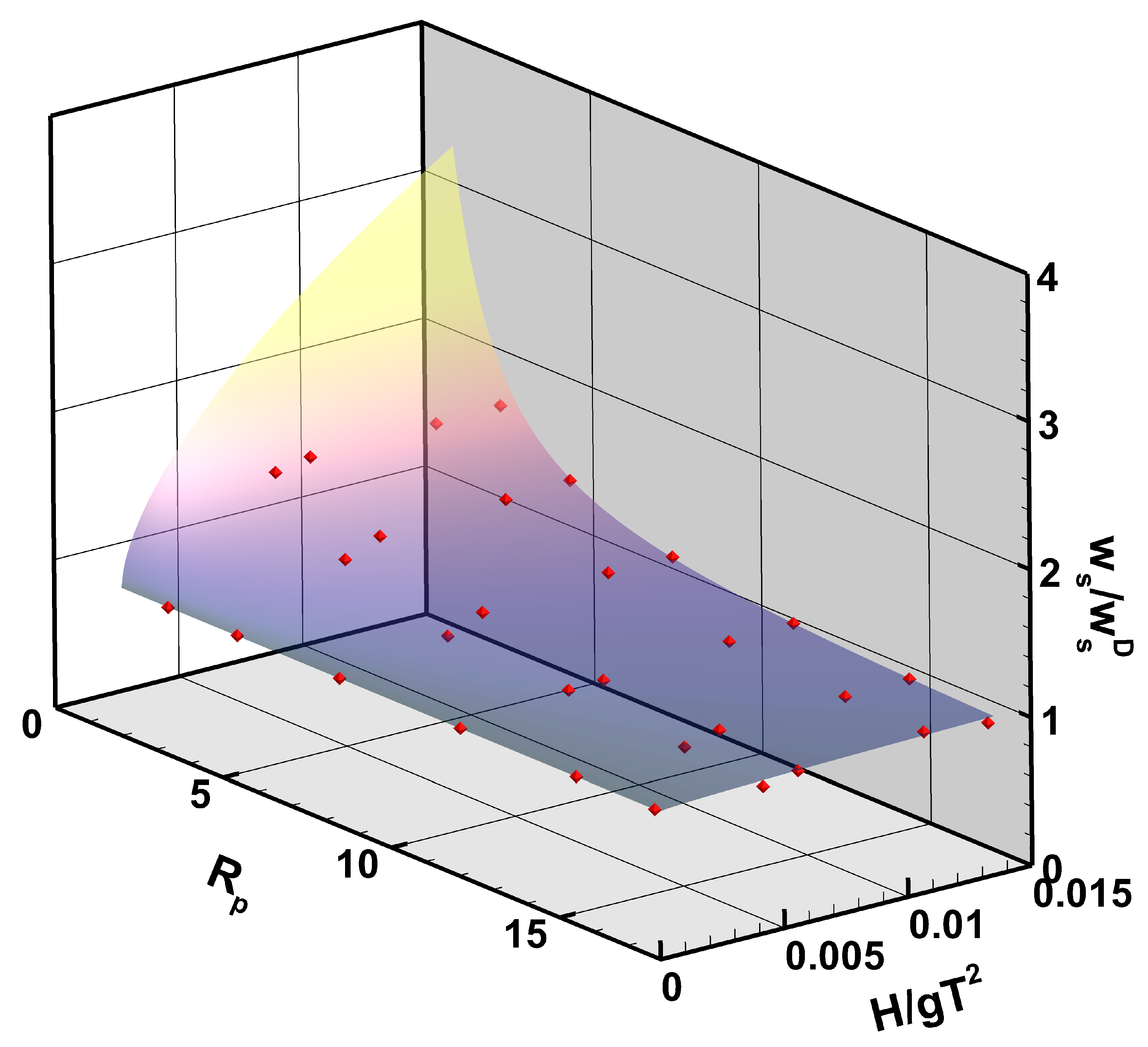
| Wave Condition | H (m) | T (s) | R | Exp. | |
|---|---|---|---|---|---|
| W1 | 0.031 | 0.85 | 0.23 | 0.0044 | 7–12 |
| W2 | 0.041 | 0.85 | 0.16 | 0.0058 | 13–18 |
| W3 | 0.077 | 0.85 | 0.17 | 0.0108 | 19–24 |
| W4 | 0.033 | 0.5 | 0.18 | 0.0134 | 25–30 |
| Class | (μm) | (μm) | (μm) |
|---|---|---|---|
| 1 | 512 | 543 | 574 |
| 2 | 468 | 498 | 528 |
| 3 | 417 | 433 | 451 |
| 4 | 307 | 338 | 368 |
| 5 | 217 | 241 | 267 |
| 6 | 173 | 183 | 193 |
| Exp. | (μm) | T (s) | H (m) | ||
|---|---|---|---|---|---|
| 007 | 543 | 0.85 | 0.031 | 0.029 | 0.214 |
| 008 | 498 | 0.85 | 0.031 | 0.024 | 0.177 |
| 009 | 433 | 0.85 | 0.031 | 0.017 | 0.127 |
| 010 | 338 | 0.85 | 0.031 | 0.011 | 0.079 |
| 011 | 241 | 0.85 | 0.031 | 0.006 | 0.044 |
| 012 | 183 | 0.85 | 0.031 | 0.003 | 0.023 |
| 013 | 543 | 0.85 | 0.041 | 0.029 | 0.214 |
| 014 | 498 | 0.85 | 0.041 | 0.024 | 0.177 |
| 015 | 433 | 0.85 | 0.041 | 0.017 | 0.127 |
| 016 | 338 | 0.85 | 0.041 | 0.011 | 0.079 |
| 017 | 241 | 0.85 | 0.041 | 0.006 | 0.044 |
| 018 | 183 | 0.85 | 0.041 | 0.003 | 0.023 |
| 019 | 543 | 0.85 | 0.077 | 0.029 | 0.214 |
| 020 | 498 | 0.85 | 0.077 | 0.024 | 0.177 |
| 021 | 433 | 0.85 | 0.077 | 0.017 | 0.127 |
| 022 | 338 | 0.85 | 0.077 | 0.011 | 0.079 |
| 023 | 241 | 0.85 | 0.077 | 0.006 | 0.044 |
| 024 | 183 | 0.85 | 0.077 | 0.003 | 0.023 |
| 025 | 543 | 0.5 | 0.033 | 0.029 | 0.363 |
| 026 | 498 | 0.5 | 0.033 | 0.024 | 0.302 |
| 027 | 433 | 0.5 | 0.033 | 0.017 | 0.216 |
| 028 | 338 | 0.5 | 0.033 | 0.011 | 0.135 |
| 029 | 241 | 0.5 | 0.033 | 0.006 | 0.075 |
| 030 | 183 | 0.5 | 0.033 | 0.003 | 0.040 |
Publisher’s Note: MDPI stays neutral with regard to jurisdictional claims in published maps and institutional affiliations. |
© 2021 by the authors. Licensee MDPI, Basel, Switzerland. This article is an open access article distributed under the terms and conditions of the Creative Commons Attribution (CC BY) license (http://creativecommons.org/licenses/by/4.0/).
Share and Cite
De Leo, A.; Cutroneo, L.; Sous, D.; Stocchino, A. Settling Velocity of Microplastics Exposed to Wave Action. J. Mar. Sci. Eng. 2021, 9, 142. https://doi.org/10.3390/jmse9020142
De Leo A, Cutroneo L, Sous D, Stocchino A. Settling Velocity of Microplastics Exposed to Wave Action. Journal of Marine Science and Engineering. 2021; 9(2):142. https://doi.org/10.3390/jmse9020142
Chicago/Turabian StyleDe Leo, Annalisa, Laura Cutroneo, Damien Sous, and Alessandro Stocchino. 2021. "Settling Velocity of Microplastics Exposed to Wave Action" Journal of Marine Science and Engineering 9, no. 2: 142. https://doi.org/10.3390/jmse9020142
APA StyleDe Leo, A., Cutroneo, L., Sous, D., & Stocchino, A. (2021). Settling Velocity of Microplastics Exposed to Wave Action. Journal of Marine Science and Engineering, 9(2), 142. https://doi.org/10.3390/jmse9020142








